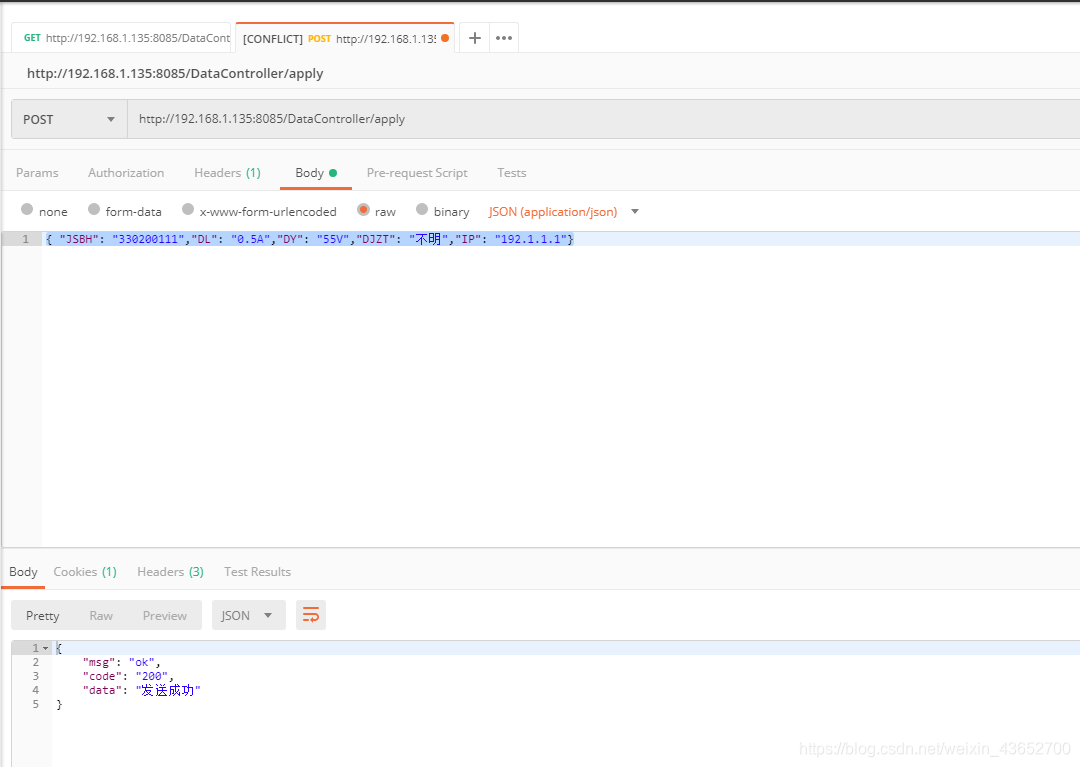注:最近项目到了尾声,需要同步友商数据,网上看了好多接收json的代码,都是用的io流方式,搞不懂如何入库,自己写了写改了改,.
一: json接收类,
第一个接口为直接传参接收
第二个接口接收json字符串
可以写个HTTP测试类调用测试,也可以postman测试调用,实例方法贴到下面
package com.gt.information.controller;
import com.alibaba.fastjson.JSONObject;
import com.gt.information.dao.DataDao;
import org.springframework.beans.factory.annotation.Autowired;
import org.springframework.stereotype.Controller;
import org.springframework.web.bind.annotation.RequestBody;
import org.springframework.web.bind.annotation.RequestMapping;
import org.springframework.web.bind.annotation.RequestMethod;
import org.springframework.web.bind.annotation.ResponseBody;
import javax.servlet.http.HttpServletRequest;
import java.util.ArrayList;
import java.util.HashMap;
import java.util.List;
import java.util.Map;
/*
-
@date 2020/4/20
*/
@Controller
@RequestMapping("/DataController")
public class DataController {@Autowired
private DataDao DataDao;@RequestMapping(value = “apply”, method = RequestMethod.POST, produces = “application/json;charset=UTF-8”)
@ResponseBodypublic Map<String, String> apply(@RequestBody String newMssage) {
//将获取的json字符串转换为JSONObject类型
JSONObject jsonObject = JSONObject.parseObject(newMssage);
//从JSONObject 对象中获取指定key(即这里的data)对应的值
String getDataJSBH = jsonObject.getString(“JSBH”);
String getDataIP = jsonObject.getString(“IP”);
String getDataDY = jsonObject.getString(“DY”);
String getDataDL = jsonObject.getString(“DL”);
String getDataDJZT = jsonObject.getString(“DJZT”);
List
//电网
@RequestMapping("/dw")
@ResponseBody
public Map<String,Object> dd_ddjlxx(HttpServletRequest request){
String getJSBH = request.getParameter(“JSBH”);
String getIP = request.getParameter(“IP”);
String getDY = request.getParameter(“DY”);
String getDL = request.getParameter(“DL”);
String getDJZT = request.getParameter(“DJZT”);
List
if(reNum == 1){
map.put("data","发送成功");
map.put("msg","ok");
map.put("code","200");
return map;
}
map.put("data","发送失败");
map.put("msg","ok");
map.put("code","777");
return map;
}
}
二:HTTP工具类
package com.gt.common.util;
import org.apache.http.NameValuePair;
import org.apache.http.client.entity.UrlEncodedFormEntity;
import org.apache.http.client.methods.CloseableHttpResponse;
import org.apache.http.client.methods.HttpGet;
import org.apache.http.client.methods.HttpPost;
import org.apache.http.client.utils.URIBuilder;
import org.apache.http.entity.ContentType;
import org.apache.http.entity.StringEntity;
import org.apache.http.impl.client.CloseableHttpClient;
import org.apache.http.impl.client.HttpClients;
import org.apache.http.message.BasicNameValuePair;
import org.apache.http.util.EntityUtils;
import java.io.IOException;
import java.net.URI;
import java.util.ArrayList;
import java.util.List;
import java.util.Map;
/**
-
@author xl
-
@date 2020/4/1-17:04
*/
public class HttpClientUtil { public static String doGet(String url, Map<String, String> param) {// 创建Httpclient对象
CloseableHttpClient httpclient = HttpClients.createDefault();String resultString = “”;
CloseableHttpResponse response = null;
try {
// 创建uri
URIBuilder builder = new URIBuilder(url);
if (param != null) {
for (String key : param.keySet()) {
builder.addParameter(key, param.get(key));
}
}
URI uri = builder.build();
// 创建http GET请求
HttpGet httpGet = new HttpGet(uri);
// 执行请求
response = httpclient.execute(httpGet);
// 判断返回状态是否为200
if (response.getStatusLine().getStatusCode() == 200) {
resultString = EntityUtils.toString(response.getEntity(), “UTF-8”);
}
} catch (Exception e) {
e.printStackTrace();
} finally {
try {
if (response != null) {
response.close();
}
httpclient.close();
} catch (IOException e) {
e.printStackTrace();
}
}
return resultString;
}public static String doGet(String url) {
return doGet(url, null);
}public static String doPost(String url, Map<String, String> param) {
// 创建Httpclient对象
CloseableHttpClient httpClient = HttpClients.createDefault();
CloseableHttpResponse response = null;
String resultString = “”;
try {
// 创建Http Post请求
HttpPost httpPost = new HttpPost(url);
// 创建参数列表
if (param != null) {
List paramList = new ArrayList<>();
for (String key : param.keySet()) {
paramList.add(new BasicNameValuePair(key, param.get(key)));
}
// 模拟表单
UrlEncodedFormEntity entity = new UrlEncodedFormEntity(paramList);
httpPost.setEntity(entity);
}
// 执行http请求
response = httpClient.execute(httpPost);
resultString = EntityUtils.toString(response.getEntity(), “utf-8”);
} catch (Exception e) {
e.printStackTrace();
} finally {
try {
response.close();
} catch (IOException e) {
// TODO Auto-generated catch block
e.printStackTrace();
}
}return resultString;}
public static String doPost(String url) {
return doPost(url, null);
}public static String doPostJson(String url, String json) {
// 创建Httpclient对象
CloseableHttpClient httpClient = HttpClients.createDefault();
CloseableHttpResponse response = null;
String resultString = “”;
try {
// 创建Http Post请求
HttpPost httpPost = new HttpPost(url);
// 创建请求内容
StringEntity entity = new StringEntity(json, ContentType.APPLICATION_JSON);
httpPost.setEntity(entity);
// 执行http请求
response = httpClient.execute(httpPost);
resultString = EntityUtils.toString(response.getEntity(), “utf-8”);
} catch (Exception e) {
e.printStackTrace();
} finally {
try {
response.close();
} catch (IOException e) {
e.printStackTrace();
}
}return resultString;}
}
三:Test测试类
package com.gt.jszd.analysis.controller;
/**
- @author xl
- @date 2020/4/2-11:36
*/
import com.gt.common.util.HttpClientUtil;
import net.sf.json.JSONObject;
import org.apache.commons.httpclient.HttpStatus;
import org.apache.http.HttpResponse;
import org.apache.http.client.HttpClient;
import org.apache.http.client.methods.HttpPost;
import org.apache.http.entity.StringEntity;
import org.apache.http.impl.client.DefaultHttpClient;
import org.apache.http.message.BasicHeader;
import org.apache.http.protocol.HTTP;
import java.io.BufferedReader;
import java.io.InputStream;
import java.io.InputStreamReader;
import java.util.ArrayList;
import java.util.HashMap;
import java.util.List;
import java.util.Map;
public class TestOne {
public static void main(String[] args) {
//JSONObject jsobj1 = new JSONObject();
JSONObject jsobj2 = new JSONObject();
Map<String, String> jsobj1 = new HashMap<String, String>();
/* map.put(“deviceID”, “112”);
map.put(“channel”, “channel”);
map.put(“state”, “0”);
map.put(“item”, “132564”);
map.put(“requestCommand”, “control”);
map.put(“FWQQ_NR”, “123”);*/
jsobj1.put(“JSBH”, “330200111”);
jsobj1.put(“DL”, “0.8A”);
jsobj1.put(“DY”, “2.5V”);
jsobj1.put(“DJZT”, “正常”);
jsobj1.put(“IP”, “192.168.2.135”);
/List
jsobj2.put("DL", "0.3A");
jsobj2.put("DY", "2.2V");
jsobj2.put("DJZT", "异常");
jsobj2.put("IP", "192.168.1.135");
//list.add(jsobj1);
String url="http://192.168.1.135:8085/DataController/apply";
// String url="http://192.168.1.135:8085/DataController/Test";
//post(jsobj2, "http://192.168.1.135:8085/TestConttroller/apply");
post(jsobj2, url);
//HttpClientUtil.doPost(url, jsobj1);
//HttpClientUtil.doPostJson(url, jsobj1.toString());
}
public static String post(JSONObject json, String path) {
String result = "";
try {
HttpClient client = new DefaultHttpClient();
HttpPost post = new HttpPost(path);
post.setHeader("Content-Type", "appliction/json");
post.addHeader("Authorization", "Basic YWRtaW46");
//StringEntity s = new StringEntity(json.toString(), "utf-8");
StringEntity s = new StringEntity(json.toString(), "utf-8");
s.setContentEncoding(new BasicHeader(HTTP.CONTENT_TYPE, "appliction/json"));
post.setEntity(s);
HttpResponse httpResponse = client.execute(post);
InputStream in = httpResponse.getEntity().getContent();
BufferedReader br = new BufferedReader(new InputStreamReader(in, "utf-8"));
StringBuilder strber = new StringBuilder();
String line = null;
while ((line = br.readLine()) != null) {
strber.append(line + "\n");
}
in.close();
result = strber.toString();
if (httpResponse.getStatusLine().getStatusCode() != HttpStatus.SC_OK) {
result = "服务器异常";
}
} catch (Exception e) {
System.out.println("请求异常");
throw new RuntimeException(e);
}
System.out.println("result==" + result);
return result;
}
}
四:postman调用实例























 302
302











 被折叠的 条评论
为什么被折叠?
被折叠的 条评论
为什么被折叠?








